1996 TOYOTA TACOMA brakes
[x] Cancel search: brakesPage 54 of 196
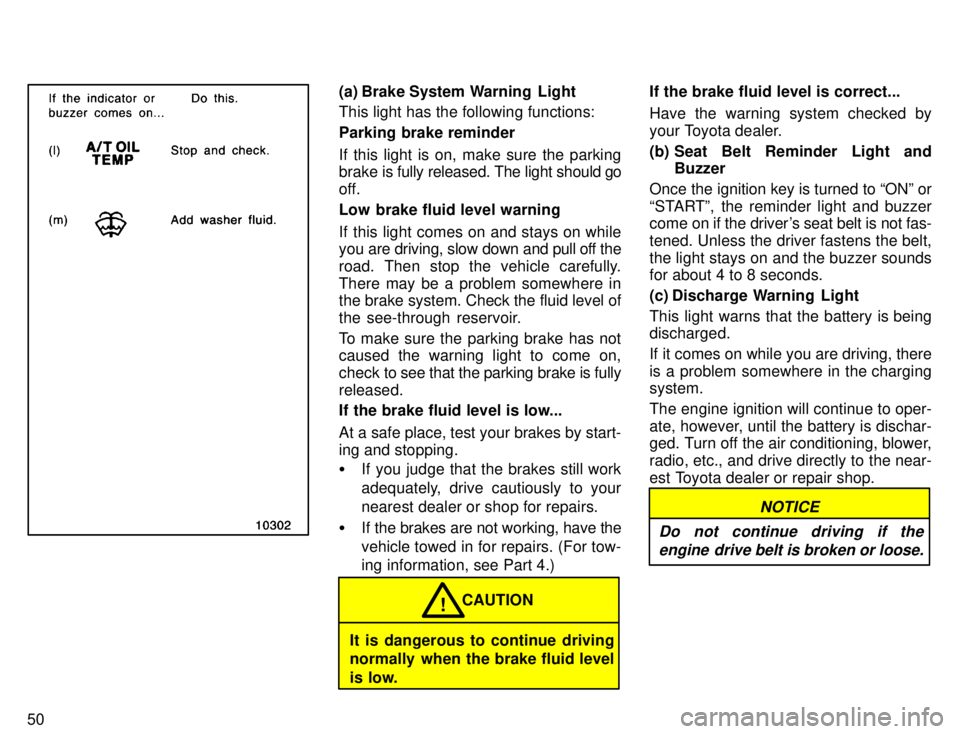
50
(a) Brake System Warning Light This light has the following functions: Parking brake reminder
If this light is on, make sure the parking
brake is fully released. The light should go
off.
Low brake fluid level warning
If this light comes on and stays on while
you are driving, slow down and pull off the
road. Then stop the vehicle carefully.There may be a problem somewhere in
the brake system. Check the fluid level of
the see-through reservoir.
To make sure the parking brake has not
caused the warning light to come on,
check to see that the parking brake is fully
released.
If the brake fluid level is low...
At a safe place, test your brakes by start-
ing and stopping. � If you judge that the brakes still work
adequately, drive cautiously to yournearest dealer or shop for repairs.
� If the brakes are not working, have the
vehicle towed in for repairs. (For tow- ing information, see Part 4.)
It is dangerous to continue driving
normally when the brake fluid level
is low. CAUTION
! If the brake fluid level is correct...
Have the warning system checked by
your Toyota dealer.
(b) Seat Belt Reminder Light and
Buzzer
Once the ignition key is turned to ONº or
STARTº, the reminder light and buzzer
come on if the driver's seat belt is not fas-
tened. Unless the driver fastens the belt, the light stays on and the buzzer sounds for about 4 to 8 seconds.
(c) Discharge Warning Light
This light warns that the battery is being discharged.
If it comes on while you are driving, there
is a problem somewhere in the charging system.
The engine ignition will continue to oper-
ate, however, until the battery is dischar-
ged. Turn off the air conditioning, blower,
radio, etc., and drive directly to the near-
est Toyota dealer or repair shop.
NOTICE
Do not continue driving if the engine drive belt is broken or loose.
Page 107 of 196
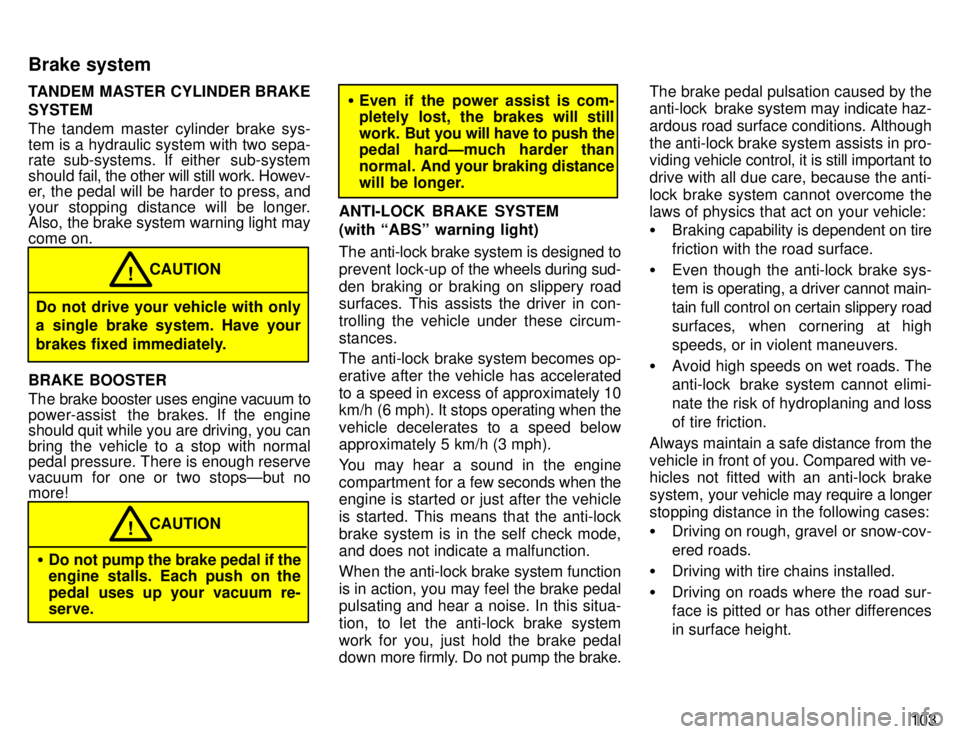
103
TANDEM MASTER CYLINDER BRAKE SYSTEM
The tandem master cylinder brake sys-
tem is a hydraulic system with two sepa-
rate sub-systems. If either sub-system
should fa
il, the other will still work. Howev-
er, the pedal will be harder to press, and
your stopping distance will be longer.
Also, the brake system warning light may come on.
CAUTION!
Do not drive your vehicle with only
a single brake system. Have your
brakes fixed immediately.
BRAKE BOOSTER
The brake booster uses engine vacuum to
power-assist the brakes. If the engine
should quit while you are driving, you can
bring the vehicle to a stop with normal
pedal pressure. There is enough reserve vacuum for one or two stopsÐbut no more!
CAUTION!
� Do not pump the brake pedal if the
engine stalls. Each push on the
pedal uses up your vacuum re- serve.
�Even if the power assist is com-
pletely lost, the brakes will still
work. But you will have to push the
pedal hardÐmuch harder than
normal. And your braking distance
will be longer.
ANTI-LOCK BRAKE SYSTEM (with ABSº warning light)
The anti-lock brake system is designed to prevent lock-up of the wheels during sud-
den braking or braking on slippery road surfaces. This assists the driver in con-
trolling the vehicle under these circum-stances.
The anti-lock brake system becomes op- erative after the vehicle has accelerated
to a speed in excess of approximately 10
km/h (6 mph). It stops operating when the
vehicle decelerates to a speed below
approximately 5 km/h (3 mph).
You may hear a sound in the engine
compartment for a few seconds when the
engine is started or just after the vehicleis started. This means that the anti-lock
brake system is in the self check mode,
and does not indicate a malfunction.
When the anti-lock brake system function is in action, you may feel the brake pedal
pulsating and hear a noise. In this situa-
tion, to let the anti-lock brake systemwork for you, just hold the brake pedal
down more firmly. Do not pump the brake. The brake pedal pulsation caused by the
anti-lock brake system may indicate haz- ardous road surface conditions. Althoughthe anti-lock brake system assists in pro-
viding
vehicle control, it is still important to
drive with all due care, because the anti-
lock brake system cannot overcome the
laws of physics that act on your vehicle: � Braking capab ility is dependent on tire
friction with the road surface.
� Even though the anti-lock brake sys-
tem is operating, a driver cannot main- tain full control on certain slippery road
surfaces, when cornering at highspeeds, or in violent maneuvers.
� Avoid high speeds on wet roads. The
anti-lock brake system cannot elimi-
nate the risk of hydroplaning and lossof tire friction.
Always maintain a safe distance from the
vehicle in front of you. Compared with ve-
hicles not fitted with an anti-lock brake
system, your vehicle may require a longer
stopping distance in the following cases: � Driving on rough, gravel or snow-cov-
ered roads.
� Driving with tire chains installed.
� Driving on roads where the road sur-
face is pitted or has other differences in surface height.
Brake system
Page 109 of 196
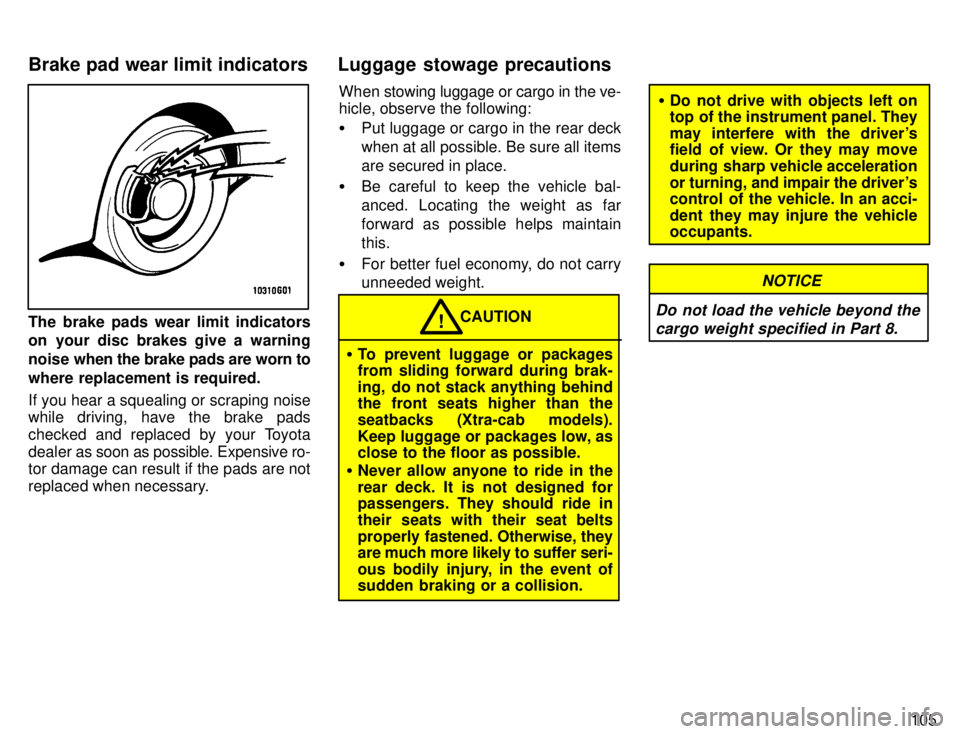
105
The brake pads wear limit indicators
on your disc brakes give a warning
noise when the brake pads are worn to
where replacement is required.
If you hear a squealing or scraping noise
while driving, have the brake pads
checked and replaced by your Toyota
dealer as soon as possible. Expensive ro-
tor damage can result if the pads are not
replaced when necessary. When stowing luggage or cargo in the ve-
hicle, observe the following: �
Put luggage or cargo in the rear deck
when at all possible. Be sure all itemsare secured in place.
� Be careful to keep the vehicle bal-anced. Locating the weight as far
forward as possible helps maintainthis.
� For better fuel economy, do not carry
unneeded weight.CAUTION!
� To prevent luggage or packages
from sliding forward during brak-
ing, do not stack anything behind
the front seats higher than the
seatbacks (Xtra-cab models).
Keep luggage or packages low, as close to the floor as possible.
� Never allow anyone to ride in the
rear deck. It is not designed for passengers. They should ride in
their seats with their seat belts
properly fastened. Otherwise, they are much more likely to suffer seri-
ous bodily injury, in the event of
sudden braking or a collision.
�Do not drive with objects left on
top of the instrument panel. They
may interfere with the driver's
field of view. Or they may move
during sharp vehicle acceleration
or turning, and impair the driver's
control of the vehicle. In an acci-
dent they may injure the vehicle occupants.
Do not load the vehicle beyond the
cargo weight specified in Part 8.
NOTICE
Luggage stowage precautions
Brake pad wear limit indicators
Page 114 of 196

11 0Before starting the engine, be sure to follow
the instructions in (a) Before crankingº. Normal starting procedure
The multiport fuel injection system/se-
quential multiport fuel injection system in
your engine automatically controls the
proper air-fuel mixture for starting. You can start a cold or hot engine as follows:
1. With your foot off the accelerator ped- al, crank the engine by turning the key to
STARTº. Release it when the engine starts.
2. After
the engine runs for about 10 sec-
onds, you are ready to drive.
If the weather is below freezing, let the en-
gine warm up for a few minutes before driving.
If the engine stalls...
Simply restart it, using the correct proce- dure given in normal starting. If the engine will not startÐ
See If your vehicle will not startº in Part 4.
�
Do not crank for more than 15 sec-onds at a time. This may overheat
the starter and wiring systems.
�Do not race a cold engine.
NOTICE
�If the engine becomes difficult tostart or stalls frequently, have the
engine checked immediately.� Always slow down in gusty crosswinds.
This will allow you much better control.
� Drive slowly onto curbs and, if pos-
sible, at a right angle. Avoid drivingonto high, sharp-edged objects and
other road hazards. Failure to do so
can lead to severe tire damage result-
ing in tire bursts.
� When parking on a hill, turn the front
wheels until they touch the curb so that
the vehicle will not roll. Apply the parking
brake, and place the transmission in Pº
(automatic) or in first or reverse (manu-
al). If necessary, block the wheels.
� Washing your vehicle or driving through
deep water may get the brakes wet. To
see whether they are wet, check that
there is no traffic near you, and then
press the pedal lightly. If you do not feel
a normal braking force, the brakes are
probably wet. To dry them, drive the ve-
hicle cautiously while lightly pressing the
brake pedal with the parking brake
pulled. If they still do not work safely, pull
to the side of the road and call a Toyota
dealer for assistance.
� Four- wheel drive modelsÐToyota rec-
ommends not using four- wheel drive on
dry hard- surfaced roads, because four-
wheel driving will cause unnecessary
noise and wear, and poor fuel economy.
(b) Starting the engine
Tips for driving in variousconditions
Page 115 of 196
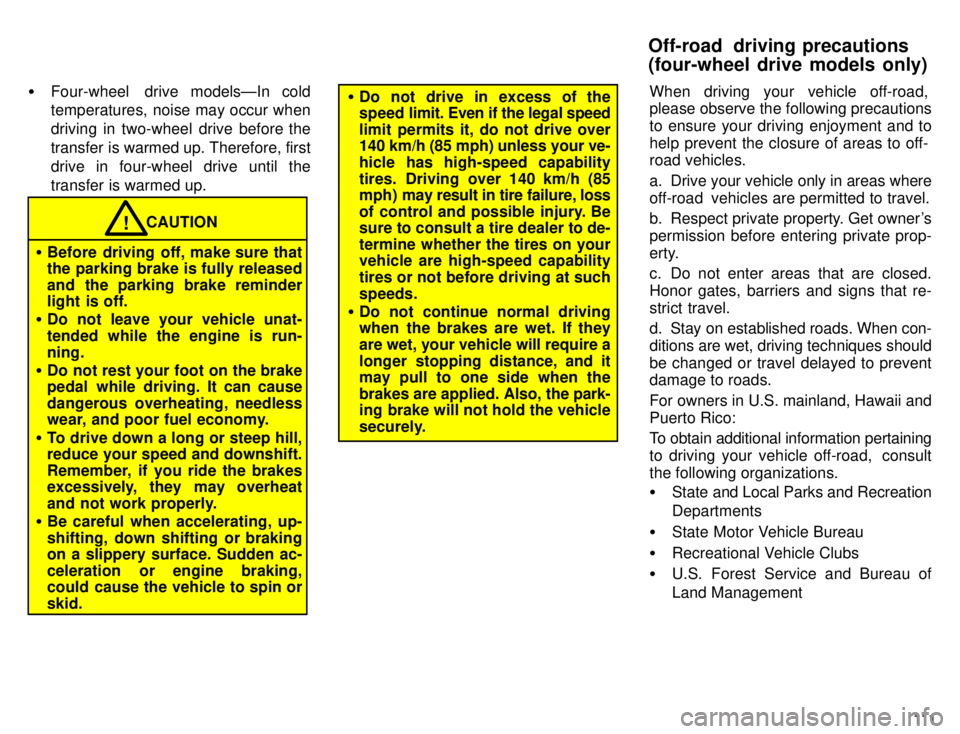
111
�
Four-wheel drive modelsÐIn cold
temperatures, noise may occur when
driving in two-wheel drive before the
transfer is warmed up. Therefore, first
drive in four-wheel drive until the
transfer is warmed up.
CAUTION
� Before driving off, make sure that
the parking brake is fully released
and the parking brake reminder
light is off.
� Do not leave your vehicle unat- tended while the engine is run-ning.
� Do not rest your foot on the brake
pedal while driving. It can cause
dangerous overheating, needless
wear, and poor fuel economy.
� To drive down a long or steep hill,reduce your speed and downshift.
Remember, if you ride the brakes
excessively, they may overheat
and not work properly.
� Be careful when accelerating, up-
shifting, down shifting or braking on a slippery surface. Sudden ac-
celeration or engine braking,
could cause the vehicle to spin or skid.!
�Do not drive in excess of the
speed lim it. Even if the legal speed
limit permits it, do not drive over
140 km/h (85 mph) unless your ve-
hicle has high-speed capability
tires. Driving over 140 km/h (85
mph) may result in tire failure, loss
of control and possible injury. Be
sure to consult a tire dealer to de-
termine whether the tires on your vehicle are high-speed capability tires or not before driving at suchspeeds.
� Do not continue normal driving
when the brakes are wet. If they
are wet, your vehicle will require a
longer stopping distance, and it
may pull to one side when the brakes are applied. Also, the park-
ing brake will not hold the vehicle
securely. When driving your vehicle off-road,
please observe the following precautions
to ensure your driving enjoyment and to
help prevent the closure of areas to off-
road vehicles.
a. Drive your vehicle only in areas where
off-road vehicles are permitted to travel.
b. Respect private property. Get owner's
permission before entering private prop-
erty.
c. Do not enter areas that are closed.
Honor gates, barriers and signs that re-
strict travel.
d. Stay on established roads. When con- ditions are wet, driving techniques should
be changed or travel delayed to prevent
damage to roads.
For owners in U.S. mainland, Hawaii and Puerto Rico:
To obtain additional information pertaining
to driving your vehicle off-road, consultthe following organizations. �
State and Local Parks and Recreation Departments
� State Motor Vehicle Bureau
� Recreational Vehicle Clubs
� U.S. Forest Service and Bureau of
Land Management
Off-road driving precautions(four-wheel drive models only)
Page 116 of 196
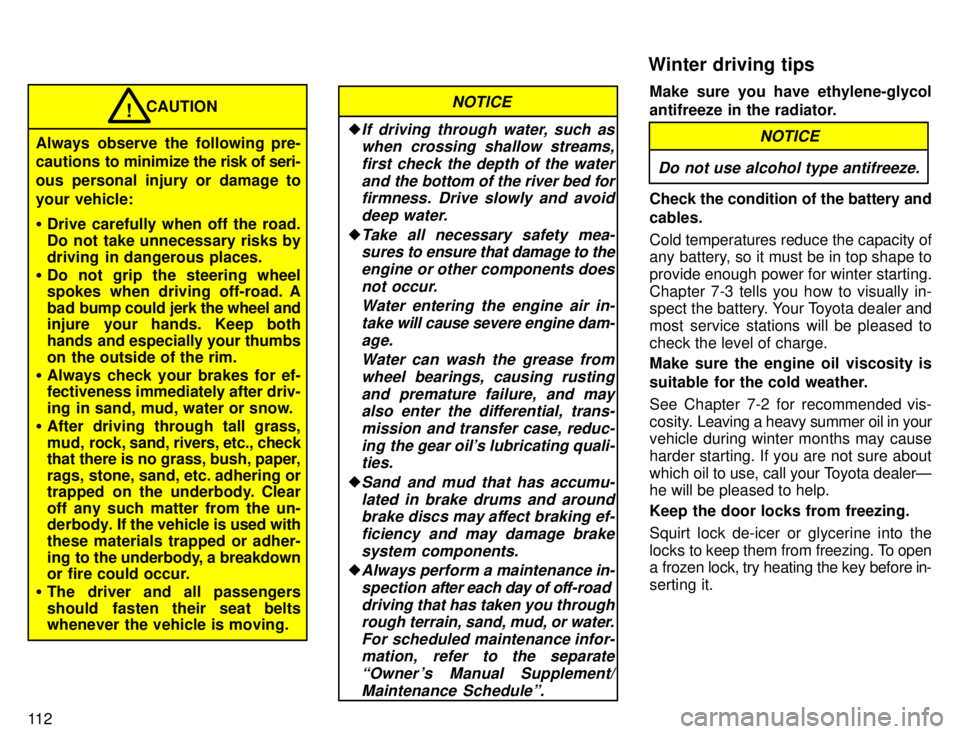
11 2
CAUTION
Always observe the following pre-
cautions to minimize the risk of seri-
ous personal injury or damage to
your vehicle: � Drive carefully when off the road.
Do not take unnecessary risks by
driving in dangerous places.
� Do not grip the steering wheel
spokes when driving off-road. A
bad bump could jerk the wheel and
injure your hands. Keep both
hands and especially your thumbs
on the outside of the rim.
� Always check your brakes for ef-
fectiveness immediately after driv-
ing in sand, mud, water or snow.
� After driving through tall grass,
mud, rock, sand, rivers, etc., check
that there is no grass, bush, paper,
rags, stone, sand, etc. adhering or
trapped on the underbody. Clear
off any such matter from the un-
derbody. If the vehicle is used with
these materials trapped or adher-
ing to the underbody, a breakdown
or fire could occur.
� The driver and all passengers
should fasten their seat belts
whenever the vehicle is moving.!
�
If driving through water, such aswhen crossing shallow streams,
first check the depth of the waterand the bottom of the river bed forfirmness. Drive slowly and avoid
deep water.
�Take all necessary safety mea-sures to ensure that damage to the
engine or other components does not occur.
Water entering the engine air in-take will cause severe engine dam-
age.
Water can wash the grease fromwheel bearings, causing rusting and premature failure, and mayalso enter the differential, trans-
mission and transfer case, reduc-ing the gear oil's lubricating quali-ties.
�Sand and mud that has accumu-
lated in brake drums and aroundbrake discs may affect braking ef-
ficiency and may damage brake system components.
�Always perform a maintenance in-spection after each day of of f-road
driving that has taken you through rough terrain, sand, mud, or water.
For scheduled maintenance infor-mation, refer to the separate
Owner 's Manual Supplement/
Maintenance Scheduleº.
NOTICEMake sure you have ethylene-glycol
antifreeze in the radiator.
Do not use alcohol type antifreeze.
NOTICE
Check the condition of the battery and cables. Cold temperatures reduce the capacity of
any battery, so it must be in top shape to provide enough power for winter starting.Chapter 7-3 tells you how to visually in-
spect the battery. Your Toyota dealer and
most service stations will be pleased tocheck the level of charge.
Make sure the engine oil viscosity is
suitable for the cold weather.
See Chapter 7-2 for recommended vis-
cosity. Leaving a heavy summer oil in your
vehicle during winter months may cause
harder starting. If you are not sure about
which oil to use, call your Toyota dealerÐ
he will be pleased to help. Keep the door locks from freezing. Squirt lock de-icer or glycerine into the
locks to keep them from freezing. To open
a frozen lock, try heating the key before in-serting it.
Winter driving tips
Page 119 of 196
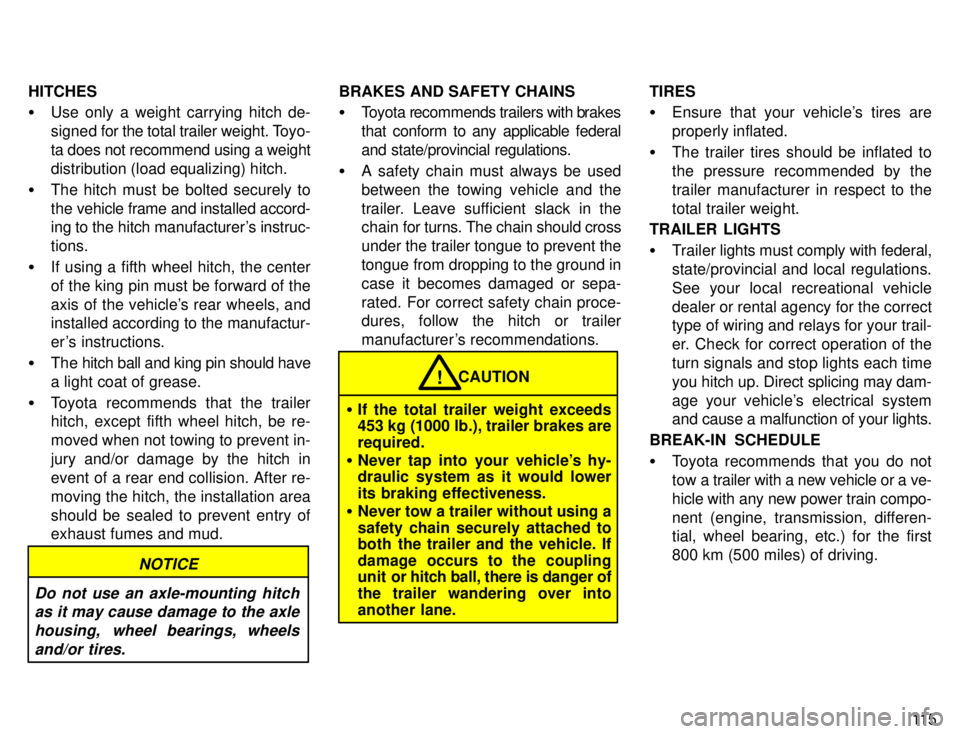
11 5
HITCHES �
Use only a weight carrying hitch de-
signed for the total trailer weight. Toyo-
ta does not recommend using a weight
distribution (load equalizing) hitch.
� The hitch must be bolted securely to
the vehicle frame and installed accord-
ing to the hitch manufacturer's instruc- tions.
� If using a fifth wheel hitch, the center
of the king pin must be forward of the
axis of the vehicle's rear wheels, and
installed according to the manufactur-
er's instructions.
� The hitch ball and king pin should havea light coat of grease.
� Toyota recommends that the trailer
hitch, except fifth wheel hitch, be re- moved when not towing to prevent in-jury and/or damage by the hitch in
event of a rear end collision. After re-moving the hitch, the installation area
should be sealed to prevent entry of exhaust fumes and mud.
Do not use an axle-mounting hitch
as it may cause damage to the axle
housing, wheel bearings, wheelsand/or tires.
NOTICE
BRAKES AND SAFETY CHAINS � Toyota recommends trailers with brakes
that conform to any applicable federal
and state/provincial regulations.
� A safety chain must always be used
between the towing vehicle and the
trailer. Leave sufficient slack in the
chain for turns. The chain should cross
under the trailer tongue to prevent the tongue from dropping to the ground in
case it becomes damaged or sepa-
rated. For correct safety chain proce-
dures, follow the hitch or trailer
manufacturer 's recommendations.
CAUTION
� If the total trailer weight exceeds
453 kg (1000 lb.), trailer brakes are required.
� Never tap into your vehicle's hy- draulic system as it would lower
its braking effectiveness.
� Never tow a trailer without using a
safety chain securely attached to
both the trailer and the vehicle. If
damage occurs to the coupling
unit or hitch ball, there is danger of
the trailer wandering over into
another lane.!
TIRES � Ensure that your vehicle's tires are
properly inflated.
� The trailer tires should be inflated to
the pressure recommended by the
trailer manufacturer in respect to the
total trailer weight.
TRAILER LIGHTS � Trailer lights must comply with federal,
state/provincial and local regulations. See your local recreational vehicle
dealer or rental agency for the correct type of wiring and relays for your trail-
er. Check for correct operation of the
turn signals and stop lights each time
you hitch up. Direct splicing may dam-
age your vehicle's electrical system
and cause a malfunction of your lights.
BREAK-IN SCHEDULE � Toyota recommends that you do not
tow a trailer with a new vehicle or a ve-
hicle with any new power train compo-
nent (engine, transmission, differen- tial, wheel bearing, etc.) for the first
800 km (500 miles) of driving.
Page 121 of 196
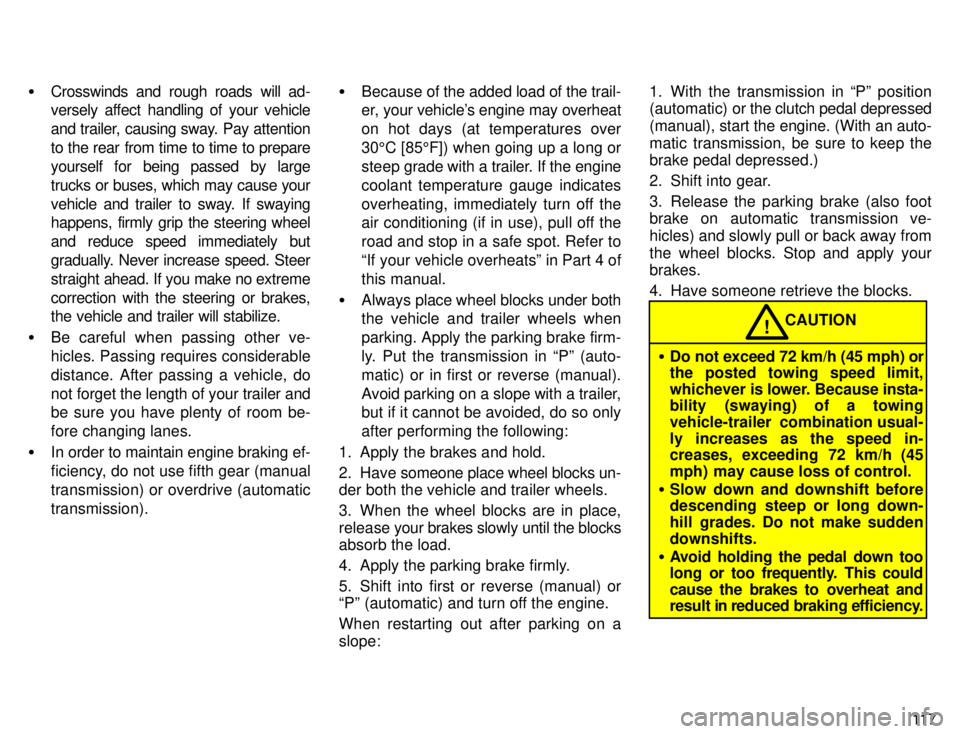
11 7
�
Crosswinds and rough roads will ad-
versely affect handling of your vehicle
and trailer, causing sway. Pay attention
to the rear from time to time to prepare
yourself for being passed by large
trucks or buses, which may cause your
vehicle and trailer to sway. If swaying
happens, firmly grip the steering wheel
and reduce speed immediately but
gradually. Never increase speed. Steer
straight ahead. If you make no extreme
correction with the steering or brakes,
the vehicle and trailer will stabilize.
� Be careful when passing other ve- hicles. Passing requires considerable
distance. After passing a vehicle, do
not forget the length of your trailer and
be sure you have plenty of room be-
fore changing lanes.
� In order to maintain engine braking ef-
ficiency, do not use fifth gear (manual
transmission) or overdrive (automatictransmission). �
Because of the added load of the trail-
er, your vehicle's engine may overheat
on hot days (at temperatures over30 5C [85 5F]) when going up a long or
steep grade with a trailer. If the engine
coolant temperature gauge indicates
overheating, immediately turn off the
air conditioning (if in use), pull off the
road and stop in a safe spot. Refer to
If your vehicle overheatsº in Part 4 ofthis manual.
� Always place wheel blocks under both
the vehicle and trailer wheels whenparking. Apply the parking brake firm-
ly. Put the transmission in Pº (auto-
matic) or in first or reverse (manual).
Avoid parking on a slope with a trailer, but if it cannot be avoided, do so only after performing the following:
1. Apply the brakes and hold.
2. Have someone place wheel blocks un-
der both the vehicle and trailer wheels.
3. When the wheel blocks are in place,
release your brakes slowly until the blocks
absorb the load.
4. Apply the parking brake firmly.
5. Shift into first or reverse (manual) or
Pº (automatic) and turn off the engine. When restarting out after parking on a slope: 1. With the transmission in Pº position
(automatic) or
the clutch pedal depressed
(manual), start the engine. (With an auto-
matic transmission, be sure to keep thebrake pedal depressed.)
2. Shift into gear.
3. Release the parking brake (also foot
brake on automatic transmission ve-
hicles) and slowly pull or back away from
the wheel blocks. Stop and apply your brakes.
4. Have someone retrieve the blocks.
� Do not exceed 72 km/h (45 mph) or
the posted towing speed limit,
whichever is lower. Because insta-
bility (swaying) of a towing
vehicle-trailer combination usual-
ly increases as the speed in-
creases, exceeding 72 km/h (45
mph) may cause loss of control.
� Slow down and downshift before
descending steep or long down-
hill grades. Do not make suddendownshifts.
� Avoid holding the pedal down too
long or too frequently. This could
cause the brakes to overheat and
result in reduced braking efficiency.
CAUTION!